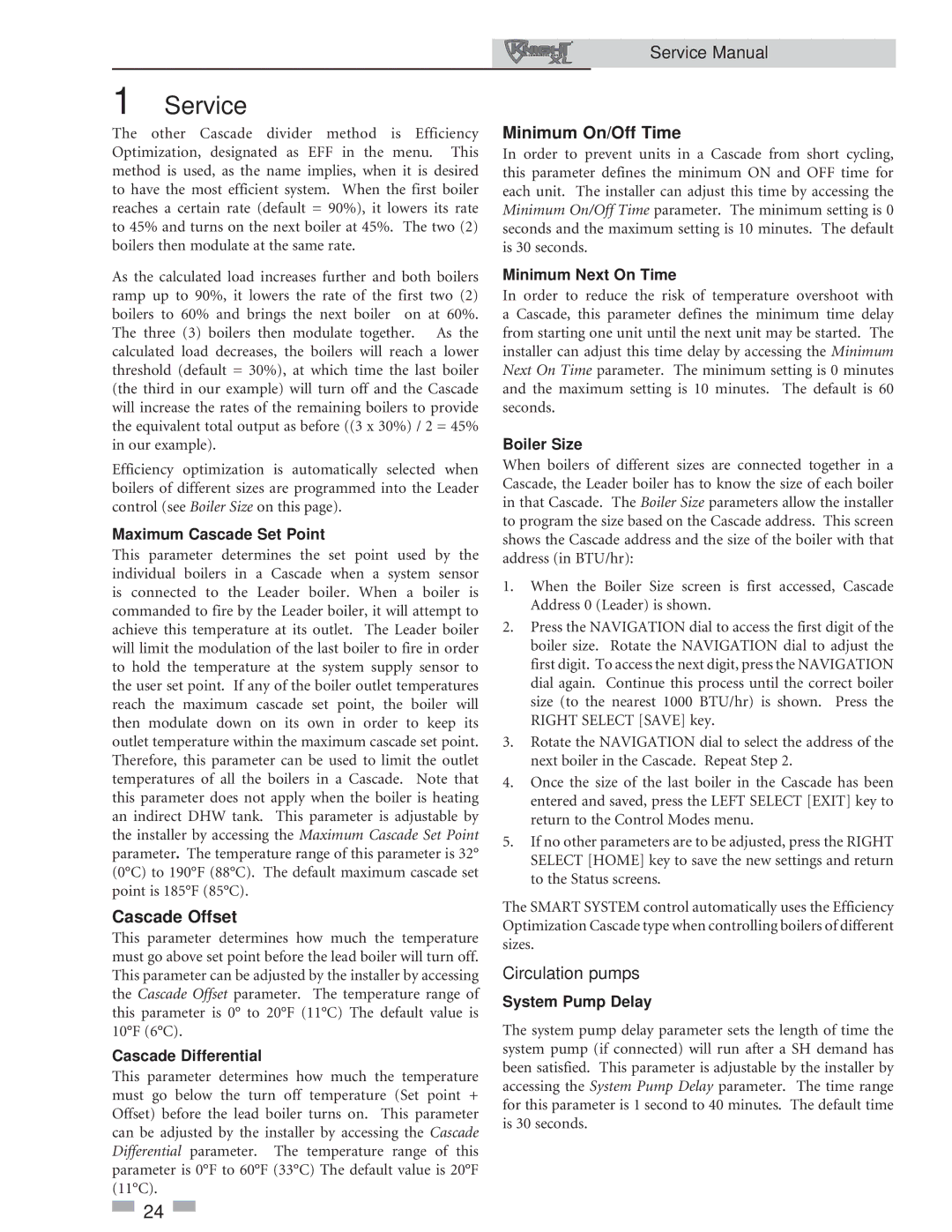1 Service
The other Cascade divider method is Efficiency Optimization, designated as EFF in the menu. This method is used, as the name implies, when it is desired to have the most efficient system. When the first boiler reaches a certain rate (default = 90%), it lowers its rate to 45% and turns on the next boiler at 45%. The two (2) boilers then modulate at the same rate.
As the calculated load increases further and both boilers ramp up to 90%, it lowers the rate of the first two (2) boilers to 60% and brings the next boiler on at 60%. The three (3) boilers then modulate together. As the calculated load decreases, the boilers will reach a lower threshold (default = 30%), at which time the last boiler (the third in our example) will turn off and the Cascade will increase the rates of the remaining boilers to provide the equivalent total output as before ((3 x 30%) / 2 = 45% in our example).
Efficiency optimization is automatically selected when boilers of different sizes are programmed into the Leader control (see Boiler Size on this page).
Maximum Cascade Set Point
This parameter determines the set point used by the individual boilers in a Cascade when a system sensor is connected to the Leader boiler. When a boiler is commanded to fire by the Leader boiler, it will attempt to achieve this temperature at its outlet. The Leader boiler will limit the modulation of the last boiler to fire in order to hold the temperature at the system supply sensor to the user set point. If any of the boiler outlet temperatures reach the maximum cascade set point, the boiler will then modulate down on its own in order to keep its outlet temperature within the maximum cascade set point. Therefore, this parameter can be used to limit the outlet temperatures of all the boilers in a Cascade. Note that this parameter does not apply when the boiler is heating an indirect DHW tank. This parameter is adjustable by the installer by accessing the Maximum Cascade Set Point parameter. The temperature range of this parameter is 32° (0°C) to 190°F (88°C). The default maximum cascade set point is 185°F (85°C).
Cascade Offset
This parameter determines how much the temperature must go above set point before the lead boiler will turn off. This parameter can be adjusted by the installer by accessing the Cascade Offset parameter. The temperature range of this parameter is 0° to 20°F (11°C) The default value is 10°F (6°C).
Cascade Differential
This parameter determines how much the temperature must go below the turn off temperature (Set point + Offset) before the lead boiler turns on. This parameter can be adjusted by the installer by accessing the Cascade Differential parameter. The temperature range of this parameter is 0°F to 60°F (33°C) The default value is 20°F (11°C).
 24
24 
Service Manual
Minimum On/Off Time
In order to prevent units in a Cascade from short cycling, this parameter defines the minimum ON and OFF time for each unit. The installer can adjust this time by accessing the Minimum On/Off Time parameter. The minimum setting is 0 seconds and the maximum setting is 10 minutes. The default is 30 seconds.
Minimum Next On Time
In order to reduce the risk of temperature overshoot with a Cascade, this parameter defines the minimum time delay from starting one unit until the next unit may be started. The installer can adjust this time delay by accessing the Minimum Next On Time parameter. The minimum setting is 0 minutes and the maximum setting is 10 minutes. The default is 60 seconds.
Boiler Size
When boilers of different sizes are connected together in a Cascade, the Leader boiler has to know the size of each boiler in that Cascade. The Boiler Size parameters allow the installer to program the size based on the Cascade address. This screen shows the Cascade address and the size of the boiler with that address (in BTU/hr):
1.When the Boiler Size screen is first accessed, Cascade Address 0 (Leader) is shown.
2.Press the NAVIGATION dial to access the first digit of the boiler size. Rotate the NAVIGATION dial to adjust the first digit. To access the next digit, press the NAVIGATION dial again. Continue this process until the correct boiler size (to the nearest 1000 BTU/hr) is shown. Press the RIGHT SELECT [SAVE] key.
3.Rotate the NAVIGATION dial to select the address of the next boiler in the Cascade. Repeat Step 2.
4.Once the size of the last boiler in the Cascade has been entered and saved, press the LEFT SELECT [EXIT] key to return to the Control Modes menu.
5.If no other parameters are to be adjusted, press the RIGHT SELECT [HOME] key to save the new settings and return to the Status screens.
The SMART SYSTEM control automatically uses the Efficiency Optimization Cascade type when controlling boilers of different sizes.
Circulation pumps
System Pump Delay
The system pump delay parameter sets the length of time the system pump (if connected) will run after a SH demand has been satisfied. This parameter is adjustable by the installer by accessing the System Pump Delay parameter. The time range for this parameter is 1 second to 40 minutes. The default time is 30 seconds.
